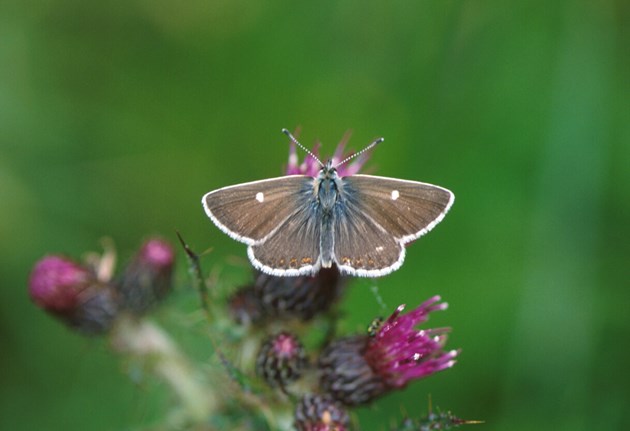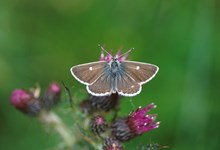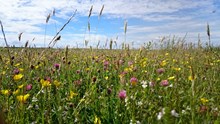03 June, 2023
Species on the Edge partnership news release: New species conservation programme tackling the decline of vulnerable coastal species in Scotland launched today

Eight leading conservation organisations have launched an innovative new multi-species conservation programme, Species on the Edge, focussed on reversing the decline of vulnerable coastal species in Scotland.
Species on the Edge is a new bold and ambitious partnership programme of NatureScot and seven nature conservation charities, all dedicated to improving the fortunes of 37 priority species found along Scotland's coast and islands. The programme celebrated its official launch today (June 3) with a free and open-to-all launch event at Logie Quarry near Tain. The launch event was organised by Butterfly Conservation, which are leading Species on the Edge on the East Coast, and hosted by Balnagown Estate, which own the site.
With £4 million funding from the National Lottery Heritage Fund, and an overall programme cost of over £6.5 million, the Species on the Edge partnership will deliver a four-and-a-half-year programme of work to tackle the impacts of environmental change on wildlife, benefiting both nature and people. Together the eight partners are combining their collective expertise to tackle species decline across seven landscape areas in Scotland: the Outer Hebrides; the Inner Hebrides, Argyll and Lochaber; the East Coast; the North Coast; Orkney; the Solway coast; and Shetland.
The Species on the Edge partners are Amphibian and Reptile Conservation, The Bat Conservation Trust, Buglife, Bumblebee Conservation Trust, Butterfly Conservation, NatureScot, Plantlife and RSPB Scotland.
Scotland’s coast and islands are amongst the most biodiverse areas in the UK. They provide a last refuge for some of our most beautiful and unusual, but also most vulnerable, species. Many are in decline and some are on the cusp of extinction.
The State of Nature Scotland 2019 reported a decline in 49% of Scotland’s species since 1970, with 91 species critically endangered. Habitat loss, climate change, pollution, invasive species, disease, and changes to land management practice are key drivers of biodiversity decline.
While human activities have contributed to the rates of biodiversity decline, people are also at the heart of reversing this decline. Working with local communities, Species on the Edge aims to:
- secure and improve the future for coastal and island species in Scotland
- form a support network between communities, to safeguard vulnerable biodiversity
- strengthen the partnership approach to conservation work in Scotland
- raise awareness of the importance of biodiversity to Scotland.
Programme activity will include species survey and monitoring, habitat creation and restoration, education and learning events, advice for land managers, volunteering opportunities, training workshops, traineeships, work experience and more.
Species on the Edge’s priority species include amphibians, birds, bats, plants, butterflies, bumblebees and a number of other invertebrates. The launch event will focus on the Small Blue butterfly – one of the project’s priority species in the East Coast area which breeds at Logie Quarry.
Nick Halfhide, NatureScot’s Director of Nature and Climate Change, said: “It’s fantastic to see Species on the Edge launching. It is an excellent example of what can be achieved through working in partnership and, in the face of the biodiversity crisis, will help us to maximise efforts to secure a future for vulnerable species on Scotland’s coasts and islands.”
Caroline Clark, Director for Scotland, The National Lottery Heritage Fund, said: “Scotland’s coastline is dramatic, rugged, wild and beautiful. At the same time it is home to a fragile ecology, a natural heritage that we have a duty to protect.”
“I am delighted that thanks to National Lottery Players we are able to fund Species on the Edge to work with communities around Scotland’s coast and islands to safeguard and nurture some of our most vulnerable species.”
Butterfly Conservation have been working with Balnagown Estate at Logie Quarry to support the fragile species which can be found in its numerous habitats: heather, scrub, woodland, lochans, seasonal pools, and sand. Without the work undertaken there to enhance butterfly habitat, the Small Blue, the UK’s smallest butterfly, would have been lost from the site. Further conservation work will continue at the quarry as part of the Species on the Edge programme and volunteers will be trained to survey and monitor the biodiversity in the area.
Callum Paterson, factor of Balnagown, said: “We’re delighted to host the event today. It is heartening to see how biodiversity has improved at the site due to the work Butterfly Conservation have undertaken and we look forward to continuing to work in collaboration during Species on the Edge.”
Tracy Munro, Species on the Edge Project Officer for Butterfly Conservation, said: “We were thrilled to launch this important project to the public at Logie Quarry where the Balnagown Estate is working with us to conserve habitat for the threatened Small Blue and Dingy Skipper butterflies. This project will make a tangible difference to so many species in Scotland and we’re proud and excited to begin alongside our partner organisations and volunteers.”
NOTE - FOR MEDIA QUERIES TODAY (Saturday), contact Eilidh Ross on 07954 144 375.
Contact information
- Name
- NatureScot Media
- Telephone
- 0131 316 2655
- media@nature.scot
Notes to editors
More information about Species on the Edge can be found at https://www.nature.scot/scotlands-biodiversity/species-edge-sote, @SpeciesEdge on Twitter or @SpeciesontheEdge on Facebook
The Amphibian and Reptile Conservation Trust (ARC) is a national wildlife charity focusing on toads, frogs, newts, snakes, lizards and marine turtles. ARC conserves amphibians and reptiles, and the habitats on which they depend, to protect them for future generations. The Trust runs species recovery programmes, monitoring, scientific research, advocacy, outreach and regional projects. ARC owns 24 nature reserves and manages 80, covering 1,900 hectares, and works with a wide range of partner organisations, volunteers and specialists. ARC continues a 50-year history of reptile and amphibian conservation. The charity was established in June 2009 by the Herpetological Conservation Trust (HCT), which was formed in 1989. HCT grew out of the British Herpetological Society’s Conservation Committee, formed in 1969. For more information visit www.arc-trust.org
The Bat Conservation Trust is the leading non-governmental organisation in the United Kingdom solely devoted to the conservation of bats and the landscapes on which they rely. The breadth and depth of our work is driven by our vision of a world rich in wildlife where bats and people thrive together. Through monitoring and direct conservation action we can secure the future of our bat species in Scotland.
Buglife - The Invertebrate Conservation Trust is the only charity in Europe devoted to the conservation of all invertebrates. Our aim is to halt the extinction of invertebrate species and to achieve sustainable populations of invertebrates across the UK. We are working hard to achieve this through: Undertaking practical conservation projects that will contribute to achieving our aim. Promoting the environmental importance of invertebrates and raising awareness about the challenges to their survival. Assisting in the development of legislation and policy that will ensure the conservation of invertebrates. Developing and disseminating knowledge about how to conserve invertebrates. Encouraging and supporting invertebrate conservation initiatives by other organisations in the UK, Europe and worldwide. Further information is available on Buglife’s website at www.buglife.org.uk, follow us on Twitter: @BuglifeScotland and ‘Like us’ on Facebook: Buglife – The Invertebrate Conservation Trust.
The Bumblebee Conservation Trust is a membership charity that was established in 2006 due to serious concerns about the ‘plight of the bumblebee’. In the last 80 years many bumblebee populations have crashed and two species have become extinct in the UK. The Trust carries out science, conservation, and people engagement projects across the UK www.bumblebeeconservation.org
Butterfly Conservation is the UK charity dedicated to saving butterflies, moths and our environment. Our research provides advice on how to conserve and restore habitats. We run projects to protect more than 100 threatened species and we are involved in conserving hundreds of sites and reserves across the UK.@savebutterflies . BC has more than 2200 members living in Scotland where we work closely with local communities, landowners, the Scottish Government, Scottish Natural Heritage and other conservation partners, to safeguard Scotland’s butterflies, moths and their habitats. www.butterfly-conservation.org/scotland
Plantlife is the international conservation charity working to secure a world rich in wild plants and fungi. Founded in 1989, Plantlife has 15,000 members and supporters. Wild plants and fungi are the foundation of all life on Earth. Plantlife enhances, restores, protects and celebrates our natural heritage through working with landowners, other conservation organisations, public and private bodies and the wider public. Plantlife owns 23 nature reserves covering nearly 4,500 acres across England, Scotland and Wales. We were instrumental in the creation of the Global Strategy for Plant Conservation, the Important Plant Area network and we are a registered COP Observer contributing to international conventions on climate and biodiversity. We are governed by a board of 12 trustees and have around 70 staff, located across the UK. We also support a team of 1500 volunteers who work in the field, at events and in our offices. Our Patron is The former Prince of Wales. See www.plantlife.org.uk for more information.
RSPB Scotland is part of the RSPB, the UK’s largest nature conservation charity. Protecting habitats, saving species and helping to end the nature and climate emergency. Nature is in crisis. Together we can save it.
NatureScot is Scotland's nature agency. We work to enhance our natural environment in Scotland and inspire everyone to care more about it. Our priority is a nature-rich future for Scotland and an effective response to the climate emergency. For more information, visit our website at www.nature.scot or follow us on X at https://x.com/NatureScot
’S e NatureScot buidheann nàdair na h-Alba. Bidh sinn a’ neartachadh àrainneachd na h-Alba agus a’ brosnachadh dhaoine gu barrachd suim a chur ann an nàdar. Tha e mar phrìomhachas againn gum bi nàdar na h-Alba beairteach agus gun dèilig sinn gu h-èifeachdach le èiginn na gnàth-shìde. Tha an tuilleadh fiosrachaidh aig www.nature.scot no air X aig https://x.com/NatureScot


